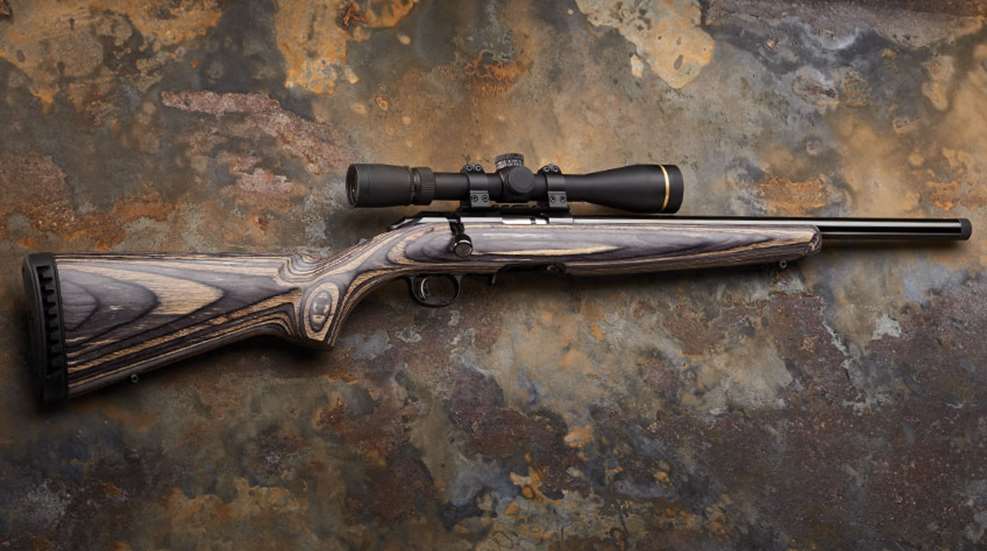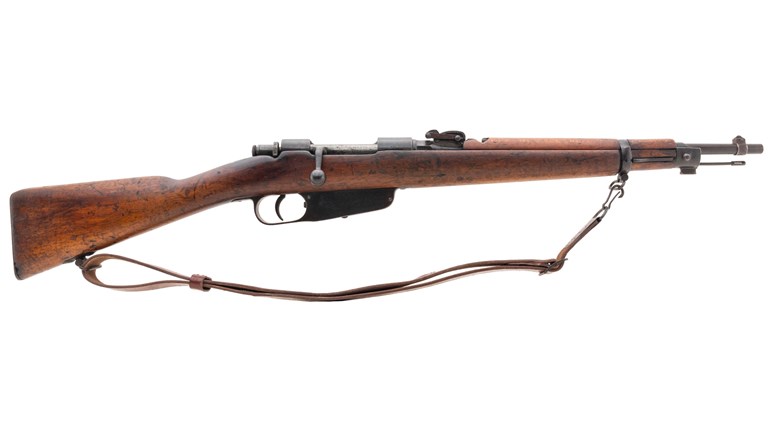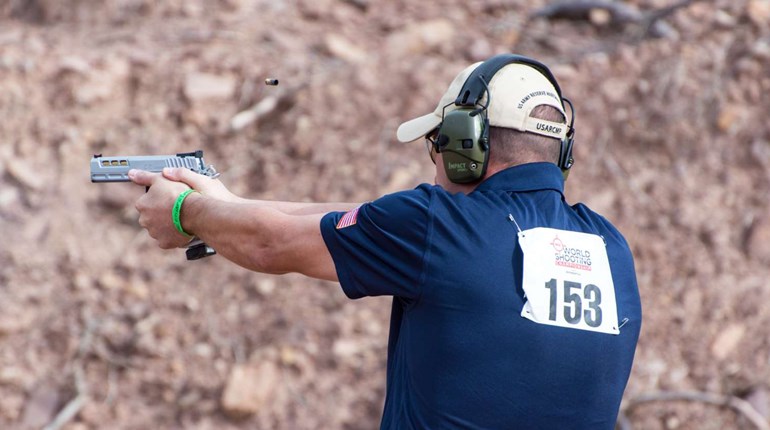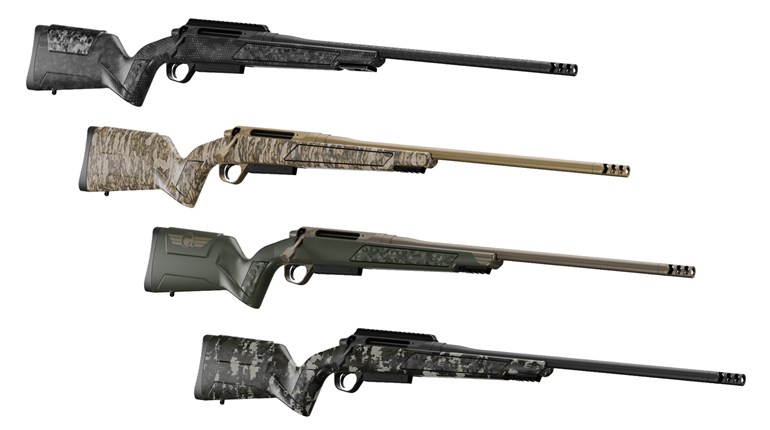
In the present era of dainty rimfire calibers, it’s easy to forget that this was not always the—ahem—case. After all, there were Gatling guns in rimfire (yes, that Gatling; and to at least .58 caliber), and even casual research points to 50-plus other rimfires of extremely varied size. Presumably, there were diverse applications to match. The late 19th and early 20th centuries saw a substantial and justifiable flight to center-fire, but it remains true that when “small” and “economical” are the causes célèbres, the remaining bantamweight utilitarians have clung to a pervasive—if humble—life.
The .17 HMR seems to be straining that “humble” business. As centerfire cartridges have trended toward less-massive bullets moving faster—and sometimes much faster—than predecessors, rimfire offerings have followed suit.
With .17 HMR, this merges useful power (mid-200 ft-lbs) with rimfire economy. And in the Ruger American Rimfire Target, it adds good looks, very pleasing accuracy and altogether classic bolt-gun appeal.
Under that “American” banner, Ruger’s budget-minded rifles have been a steadily growing presence since their introduction in 2011. Now tallying nearly two dozen rimfire and center-fire calibers from .17 HMR up to .338 Win. Mag., they’ve prospered on good rifle basics.
Central to these are a smooth-running, short-throw bolt with a paltry 60 degrees of rotation and not quite 2 inches of front-to-back travel. Combined with an action bedding system that very effectively locks out play, the 18-inch hammer-forged and threaded barrel free floats. This absence of unhelpful stock/barrel contact lets the trigger—Ruger’s 3- to 5-pound Marksman—put user-tunable delicacy to work on every shot. Like the storied 10/22 semi-automatic, it uses a flush-fitting, inexpensive and superbly reliable rotary magazine to make nine rounds available before a reload is required. When the need does arise, a factory-installed extended release renders the swap elementary.
A laminate stock—ours mostly in black and subtle purple grays—is cut with an Alexander Henry forend and comes complete with studs at front and rear. The result is a tough, dimensionally stable stock ready for use with sling, bipod or shooting sticks. The good butt pad is altogether unnecessary in recoil terms, but it does make for a secure mount of the rifle in a variety of shooting positions.
That last point is more crucial than might be expected, mainly because it’s hard to imagine a Ruger American in .17 HMR that won’t get shot a lot. Our range sessions were certainly loaded with reasons why.
First is the nature of .17 HMR ammunition relative to the other rimfire calibers. Much of the superb performance we experienced is likely attributable to the most elementary ballistic principle of all—higher velocity reduces projectile flight time, and short flight time means gravity and wind have less time to interfere with hit quality. Another fairly technical factor helps, and it relates to the center-fire trend we noted earlier: By delaying the wobble that accompanies downward transit through the Mach, or sound barrier, net accuracy is enhanced for any bullet—rimfire or center-fire. Calculations show our .17 HMR ammunition stayed consistently above the sound barrier beyond 200 yards, and thus avoided the problem. (Case size and projectile weight limitations mean .22-caliber rimfires must use other, and sometimes more complex, expedients to avoid the problem, either by never going above the sound barrier—so-called “subsonic” or “standard” ammunition—or by never falling below it within anticipated range limits, generally 50 yards for .22 lr, and 125 yards for .22 WMR.) If that sounds like “advantage .17 HMR,” we’re inclined to agree.
A second appeal is a touch less obvious, yet thoroughly vintage—the economical nature of rimfire arms. We’re far from singular in lauding this advantage for .22 lr, but there’s reason to think the .17 HMR/Ruger combination is even better in many respects. An MSRP under $500 (and a street price barely cresting $400) is enticing enough, but the completeness of the Target package ought to be an inducement as well. Other than a Harris bipod—added mainly for convenience—the Ruger didn’t want for a thing.
A Picatinny rail came mounted on the Rimfire Target receiver, and we wasted no time in getting a Leupold VX-3i 4.5-14x40 scope aboard and boresighted. This process had us kindly disposed from the get-go, and the first time you need the bolt out of a Ruger American, you’ll know why—removal is a piece of cake, and doubly safe with no trigger pull required.
It didn’t take long for promised accuracy to appear in our range sessions. That good boresight had points of aim and impact synchronized early, and a boring, tiny blob of hits on a 50-yard steel encouraged us to try further out immediately. Light quartering winds were clearly pushing the 17-grain CCI VNT a bit, but nowhere near off our target. Predictably, the 1-moa hash marks of the “Wind-Plex” reticle in the Leupold made accounting for the variations easy, and progressively smaller targets bobbed as if on command out to 200 yards.
In all, five different loads took their turn in the 1-in-9 twist bore, with an unsurprising winner—Hornady’s 17-grain VMAX. This polymer-tipped varmint round posted routine ~.650-inch, 100-yard groups with three or four holes often touching—harder than you might think with only .170-inch diameter to work with—and snugged down to the .490s when the shooter did his part. We cheerfully concede that the endgame here felt more like the rifle testing us rather than us testing the rifle, and another characteristic seemed certain: Sure improvement would require the costs and complexities of center-fire, and a better rifleman.
The only barrier to a relative run of the bolt-action rimfire table by the Ruger American Rimfire Target is a bit of a stalking horse in our view. The argument, as we hear it, attempts a comparison that the fine, affordable rifle—also available in .22 LR and .22 Magnum—makes largely moot. If you have rimfire tasks that stretch materially beyond 100 yards or want to develop rifle craft at longer distances but with lower costs than center-fire, then the .17 hmr offers decisive advantages. This is especially so if you hold with the theory, as we do, that shot placement trumps power. The .17 HMR is so flat-shooting and repeatable that foul-ups will belong almost exclusively to the shooter, barring inadequate sight technology or clearly untenable wind. If precision can take a slight back seat to delivered power and distances rarely exceed 125 yards, then seriously consider a Rimfire Target in .22 Magnum—any misses will likely hang on poor distance estimation alone. If your application is inside 75 yards, .22 LR remains the king in terms of low cost, and there should be enough practice happening that excuses are unneeded.
All of which lead us to declare that a Ruger American Rimfire Target in any caliber is unlikely to prove anything but a lasting joy.
Nuts And Bolts
Ammunition — In the parlance of grandmothers everywhere, .17 HMR ammunition has spoiled us rotten in the Ruger American. In our tests, five different varieties were chronographed and shot in numbers conclusive enough to convince us of a rare occurrence—Hornady’s mini hot-rod seems inherently accurate. This is more amazing given the traditional fickleness of rimfire. (Prove this by asking a rimfire aficionado, “How many types of ammunition does your XYZ-123 shoot well?” “Oh, most of it,” is not an answer we’ve ever encountered.)
This is not to say that it was all equivalent, but the generally superior performance was a pleasant departure from the normal, lengthy “hunt and peck” for exemplary factory ammunition. The most consistent—always valued for its ability to reduce vertical point-of-impact errors—was also the most accurate. With only 23 feet per second velocity variation, Hornady’s 17-grain VMAX commonly grouped at, and sometimes under, 1/2 inch.
Suppression — We don’t often get a chance to experiment with suppressors, mostly because there’s plenty else to tell readers about—and acquisition
of the devices remains a disheartening and costly process due to 1930s-era regulation. But with an early and successful termination of our ammunition search, the thread protector came off and stayed off for a good spell. America’s 1st Freedom contributor and extremely accomplished rifleman Tom “Hoser” Freeman was a willing, knowledgeable guide for much of our experimentation.

Foremost, suppression worked very well on the .17 HMR. We tested two cans, and got good results from both (though the Thunderbeast .22 Take Down was the winner; beautifully made and with about 2 dB more reduction). Combustion noise from the shooter’s position was in the low 120s depending on ammo choice, though the supersonic “crack!”—which cans cannot attenuate—was still evident. (In other words, keep that ear protection on.)
Hoser had a couple of reminders for us when it comes to suppressors. First, he suggests getting into the habit of removing the thread protector for all shooting, suppressed or not. They will nearly always work loose, and when loose, will change barrel harmonics and bullet impact relative to sight settings. Next, remember that suppressors change barrel harmonics too, and this is often the differentiator between good/better/best. A quality suppressor will change point of impact, but change it in the same way through on/off cycles. Cheap cans won’t.
Like to add one to a Ruger American Rimfire Target? We’d say “absolutely,” but Hoser bids us remember that you get what you pay for. The $200 Federal Tax Stamp and eight months for application processing are necessities, so why do them over unnecessarily when an unsatisfactory suppressor shows its true colors?
Optics — If you want to see us wince, suggest that rimfire rifles don’t need or deserve good optics. There’s a chain of logic, in fact, that suggests they need better-than-average sight technology: You’re likely to shoot them more and better as long as the optics aren’t holding you back. Our Leupold VX-3i 4.5-14x40 was that company’s recommendation, and we’re particularly glad to have hushed up and gone with their expertise. Trim dimensions, modest weight and simple (but very precise) controls made it a superlative match for the Rimfire Target, though perhaps the best proof of quality is anecdotal. Our best shooting under field conditions came after a range pal politely asked what we were up to. Obligingly, we hopped up to give him a through-the-scope perspective, but missed his adjustment of the magnification back down to 4.5 power. Without further adjustment, five shots at 200 yards went into 1.1 inches before the change registered. Enough said about clarity and reticle utility? We thought so, too.


































